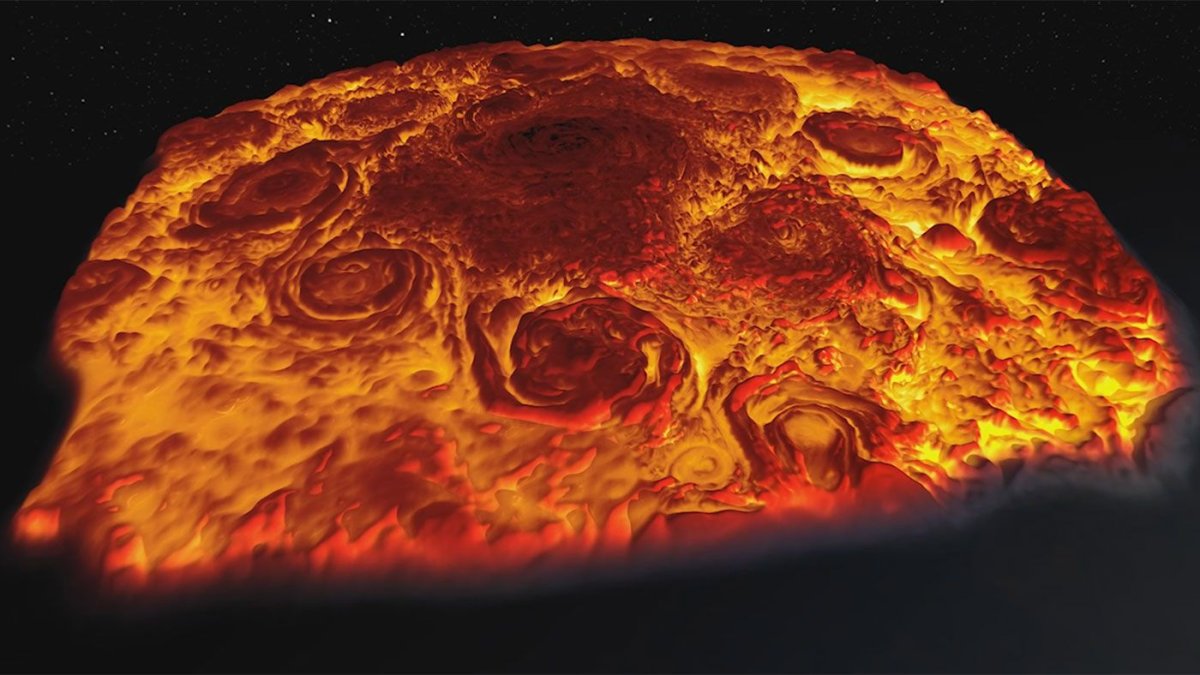NASA's Juno mission has revealed the giant cluster of cyclones at Jupiter's North Pole in incredible detail. Infrared images unlock the secrets of this colossal weather system, and will help scientists understand more about the planet's mysterious poles.
Earlier this year, scientists explored these cyclones for the first time in four papers published in the journal Nature. Now, researchers have released an infrared video of the polar cluster at the European Geosciences Union General Assembly in Vienna, Austria.
Read more: NASA Juno Unlocks Secrets of Jupiter's Mega Cyclone Clusters
Juno's Jovial InfraRed Auroral Mapper (JIRAM) captures infrared light traveling from deep within the planet. It can reveal what is happening up to 45 miles below the top of Jupiter's clouds.
The images will help scientists uncover the mysterious and violent forces behind Jupiter's cyclone clusters. Nine cyclones churn away at the planet's North Pole, each stretching between 2,500 and 2,900 miles in diameter.
"Before Juno, we could only guess what Jupiter's poles would look like," said Alberto Adriani, Juno co-investigator from the Institute for Space Astrophysics and Planetology, Rome, in a statement. "Now, with Juno flying over the poles at a close distance it permits the collection of infrared imagery on Jupiter's polar weather patterns and its massive cyclones in unprecedented spatial resolution."
Jupiter's Gassy Interior
The team also revealed some of the secrets behind the gas giant's mysterious interior. Because Juno can get so close to the planet, and because it orbits pole to pole, it has produced incredible data about the planet's rotating deep interior. "We have essentially solved the issue of how Jupiter's interior rotates," said Tristan Guillot, a Juno co-investigator from the Université Côte d'Azur, in the statement. "The zones and belts that we see in the atmosphere rotating at different speeds extend to about 1,900 miles... At this point, hydrogen becomes conductive enough to be dragged into near-uniform rotation by the planet's powerful magnetic field."

This rotation data will help scientists probe the planet's inside even further. Without it, scientists have struggled to draw conclusions about the structure and composition of Jupiter's deep interior. "Now our work can really begin in earnest—determining the interior composition of the solar system's largest planet," said Guillot.
A Magnetic Field "Unlike Anything Previously Imagined"
Researchers have also uncovered some of the secrets behind Jupiter's weird magnetic field. For the first time, they've homed in on the engine driving the planet's magnetic field.
Read more: Jupiter's Great Red Spot: Mysterious 200-year-old Storm May Be About to End
Mapping the field from eight orbit's worth of data, the team built a picture of the field from the "surface" of the planet—one Jupiter radius—to its suspected dynamo or engine. The magnetic field, they discovered, is really, really weird.
The field is highly variable at the northern hemisphere. Some areas are intense and positively charged, while others are much weaker and negatively charged. On the flip side, the southern hemisphere magnetic field is always negative, gradually becoming more intense the closer it gets to the pole.
"We're finding that Jupiter's magnetic field is unlike anything previously imagined," said Jack Connerney of the Space Research Corporation. "Juno's investigations of the magnetic environment at Jupiter represent the beginning of a new era in the studies of planetary dynamos."
Just a third of the way through its mapping mission, he added, Juno has plenty more secrets to reveal.
Uncommon Knowledge
Newsweek is committed to challenging conventional wisdom and finding connections in the search for common ground.
Newsweek is committed to challenging conventional wisdom and finding connections in the search for common ground.
About the writer
Katherine Hignett is a reporter based in London. She currently covers current affairs, health and science. Prior to joining Newsweek ... Read more
To read how Newsweek uses AI as a newsroom tool, Click here.








